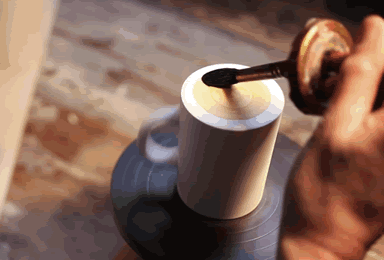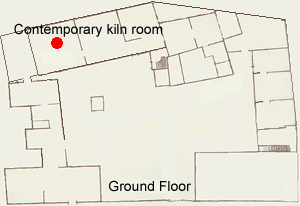
Welcome to Hjorths Fabrik
With this app, you have the opportunity to follow all the processes in the making of the high quality stoneware for what Hjorths Factory is renowned.
You can follow the process via the video films.

With this app, you have the opportunity to follow all the processes in the making of the high quality stoneware for what Hjorths Factory is renowned.
You can follow the process via the video films.

The mug is bisque fired at 950 C.
When the mugs have cooled, they are lacquered before glazing. This allows us to dip them all the way into the glaze where after we dry of the remainder of the glaze from the base of the mug.
Firstly, the mugs are glazed inside with a clear glaze afterwards they are carefully dipped into our trademark brown granite glaze.
The base is carefully cleaned before the mug is ready for the second and last firing circle.
Both glaze and clay are made of local granite and when fired to top temperatures at 1270 C the glaze and clay becomes like stone again, hence the name stoneware.
The mugs are left to cool down slowly over two days before they can be staked onto the shop shelves.

Hjorths Factory were founded in 1859 as L. Hjorths terracotta factory. The premises were situated in Østergade in Lauritz Hjorths parents’ house. The first pieces that were produced were water coolers, flowerpots and match holders. In 1862, the factory moved to its present premises in Krystalgade. Thereafter the factory mainly produced vases and figurines. In 1865, Hjorths Factory employed 10 ceramicists. Hjorths Factory produced only terracotta. The Terracotta ware was decorated with mountain scenes and roses. The latter well renowned painter and poet Holger Drachmann (1846-1908) made a living by painting on the Hjorths terracotta vases. During the1870’erne sales went up and the neighboring building was bought. The biggest cash cow were replicas of ancient Greek and roman vases Kristian Zahrtmann (1843-1917) a Danish painter posted drawings of these originals artefacts from his visits to Greece and Italy to Lauritz Hjorth in Rønne.
Kristian Zahrtmann who was a local bornholmian later became a well renowned painter. In 1880, the factory sold these vases all over the world to large department stores in Paris, Berlin, London, St. Petersburg and Vienna. Even in Australia, New York and in the West Indies on Sct. Thomas you could buy the terracotta vases from Hjorths Factory. In the 1880, new designs were developed in black terracotta. The black surface was achieved by adding pieces of coal during the firing. In 1900, when tourism came to Bornholm the factory began to produce souvenirs. Plates with landscape paintings, ashtrays, rune stones etc. The art noveau style influenced new designs in vases with large sculpted poppies on the sides or fairytale fauna.- All in the burnished black terracotta.
The 1.WW stopped all export and wares were now mainly sold in Denmark. After the 1.WW, mass-produced stoneware became the factory’s bread and butter.
From 1927 the products were stamped with the figure of a red deer.
Greybrown stoneware. 1913-40
One of Hjorths Factory’s larges successes were the greybrown stoneware. It comes as vases, jars, plates, high tea plates, tea and coffee cups, lamps, buttons, brooches, nameplates and check games. Any true bornholmian owns a piece of this famous ware designed by Lauritz daughter Thora Hjorth.
Firstly the collection was decorated with patterns in art novae style and later with scenes of birds, fruits and flowers.
Chemist Jars
In the shop in Hjorths Factory you will find canisters, containers and lidded jars in all sorts of sizes. The history of these utensils stems all the way back to 1927, where Krone Chemist in Esbjerg placed an order to Hjorths Factory. The jars had to be acid proof. As they were to be used to contain all sorts of compounds for the making of medicines. The jars were thrown in a cylindrical shape, glazed with a grey glace, and decorated with blue lettering.
The lids had a tiny knob on top. The year after chemist K. Th. Jørgensen in Rønne also ordered these jars. The jars were later made in the brown glaze we see today and the lid was redesigned a no longer features the little knob. The same jars were made in a reddish brown glaze and were in use at chemist shops all over Denmark well into the 1960. In time the jars developed into new models and the collection now encompasses a whole row of utensils. Some we know export to Muji in Tokyo.
During II WW, the factory stopped the production of the famous grey brown decorated stoneware. The company could not obtain the metal oxides for the decoration and wood supplies were hard to obtain.
This proved to be a serious problem as all the ware was fired to 1300 degrees Celsius. A tin glazed majolica was therefore designed and produced during the last world war. This ware, like the terracotta, was bisque and glaze fired at lower temperatures. Up until1960 a tea set, jugs, vases, jars and bowls in a slender tight ribbed design were produced. Peter Hjorths the son of Erik Hjorths designed this collection. During this period, wares were mostly sold locally on Bornholm.
Artists working on the factory.
In 1930, the east European sculptor Gertrud Kudielka was employed at the factory. For more than 30 years, her esthetics influenced the designs of the products. Her most famous pieces were little figurines: bears, fairytale fauna and figures in folk costumes.
In the 1950, a large group of artist was connected to the factory for shorter spells of time. To name a few, these were Adam Fischer, Ursula Munch-Petersen (daughter of Lisbeth Munch-Petersen/ grandchild of Hans Hjorths), Eva Sjøgren, and Jane Reumert amongst others.
This spring our brown glazed stoneware which stems from the chemist jar had its introduction on the international scene with a large order of coffee cups, jars, teapots, plates and sake cups from the well esteemed Japanese firm Muji in Tokyo. This order is placed for a special Scandinavian design event at their flagship store this autumn.
Try out our techniques for yourself.
In our workshop, Hanna will help you produce your own ceramic ware.
Some of the techniques are hand decorating on premade mugs, rolling and forming your own nametag, modelling of figurines or small jewelry pieces.
Try hands on throwing at the throwing wheel the most skill of all.
Please check our website for timetables and booking. Price pr. Person 95, - DKK.
Hjorths Fabrik produces small-scale batch production of our traditional brown ware.
Marie Hjorth, former owner and forth generation of the Hjorths dynasty still makes one off pieces.
Ejnar Paulsen, production manager and artisan makes hollow ware in a large palette of appealing glazes.
Please visit the shop or our webshop for pretty presents and good deals.